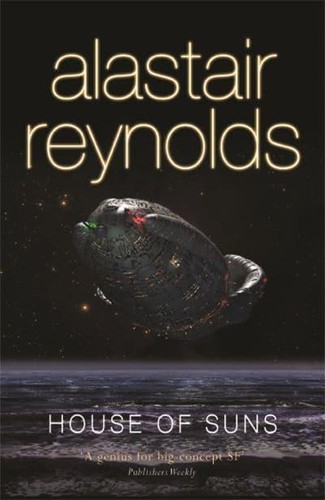Arbieroo reviewed House of Suns by Alastair Reynolds
Review of 'House of Suns' on 'Goodreads'
4 stars
Reynolds now has a sufficient body of published works for certain themes, narrative techniques and favourite tricks to be discernable; most of them are present in this novel, which has a setting independent of all his previous books.
Here we have humanity as a star-faring species for more than 6 million years from the point of view of Earth's rest frame - and if you don't know what a "rest frame" is you may have a little trouble with this book, because Special Relativity plays a crucial role in the story and Reynolds takes no time out to explain it. I can remember enough of the theory to take it in my stride, but I don't know whether it would cause a problem for a reader completely unfamiliar with the concept of time dilation. This is the first of Reynolds' themes to become obvious; no faster than light spaceships. He uses this restriction to force creativity the same way e.e. cummings used the restrictions of the sonnet form, and to great effect. I can think of no more convincing "hard SF" writer working today and it is because when it comes to current physics, he never gets it wrong. This fundamental idea forces Reynolds to find answers to questions about how galactic scale exploration could work and come up with solutions that are more or less original - even "suspended animation" gets a new look, possibly influenced by ideas from Iain M. Banks' The Algebraist.
So what has humanity been up to for 6.5 million years? Well, some of them have cloned themselves a thousand times over and started observing the life of the galaxy in near light-speed spaceships - effectively time-travelling into the future as they do so - and holding re-unions every 200,000 years or so, to share their experiences. Meanwhile, most of the rest of the species are doing what they've always done but on a bigger scale - interstellar empires come and go, evolution takes a grip in some places, science progresses.
The story is written from the perspectives of two clones of the same individual who also, against Family tradition, are lovers. They are also late for their Family re-union when they get into some trouble with an unscrupulous space-ship trader....
From there the story slowly accelerates to a break-neck pace - much like the ships in the story - in time for the conclusion. This is a technique also seen in Century Rain and Pushing Ice. It can make the reader feel somewhat underwhelmed in the first third, but the final third makes up for it every time.
There is a trick Reynolds has used repeatedly before and again here, that I feel he needs to be wary of: induced amnesia. The restoration of "erased" memory is perhaps now too obvious a trick for hiding then revealing mysterious circumstances and events. On this occassion, at least the victim is aware of the fact that he is suffering, but really I don't think Reynolds can use the idea as a significant plot device again without it being irritating.
Really that is about the most negative element of the book. The author's penchant for Gothic horrors and really unpleasant, grotesque characters is present, though dialed down a very long way from the freak-show that was Revelation Space and I could quibble that perhaps Reynolds' unique voice is made a little too generic because it has been pushed too low in the mix, this time around. Readers need characters they can like, especially in long novels, but there is a balance to be struck; perhaps Pushing Ice saw that balance being hit almost perfectly because the leading characters were so realistic yet flawed. Of course, Reynolds turned it up to 11 in Diamond Dogs - but you can do that if you're only expecting to hold the reader for 100 pages or so - more of that, please!
Overall, this is recognisable Reynolds writing a story that grips like a slowly tightening vise and drags you to some unexpected places, well worth the read and as good as any of his other longer novels.

